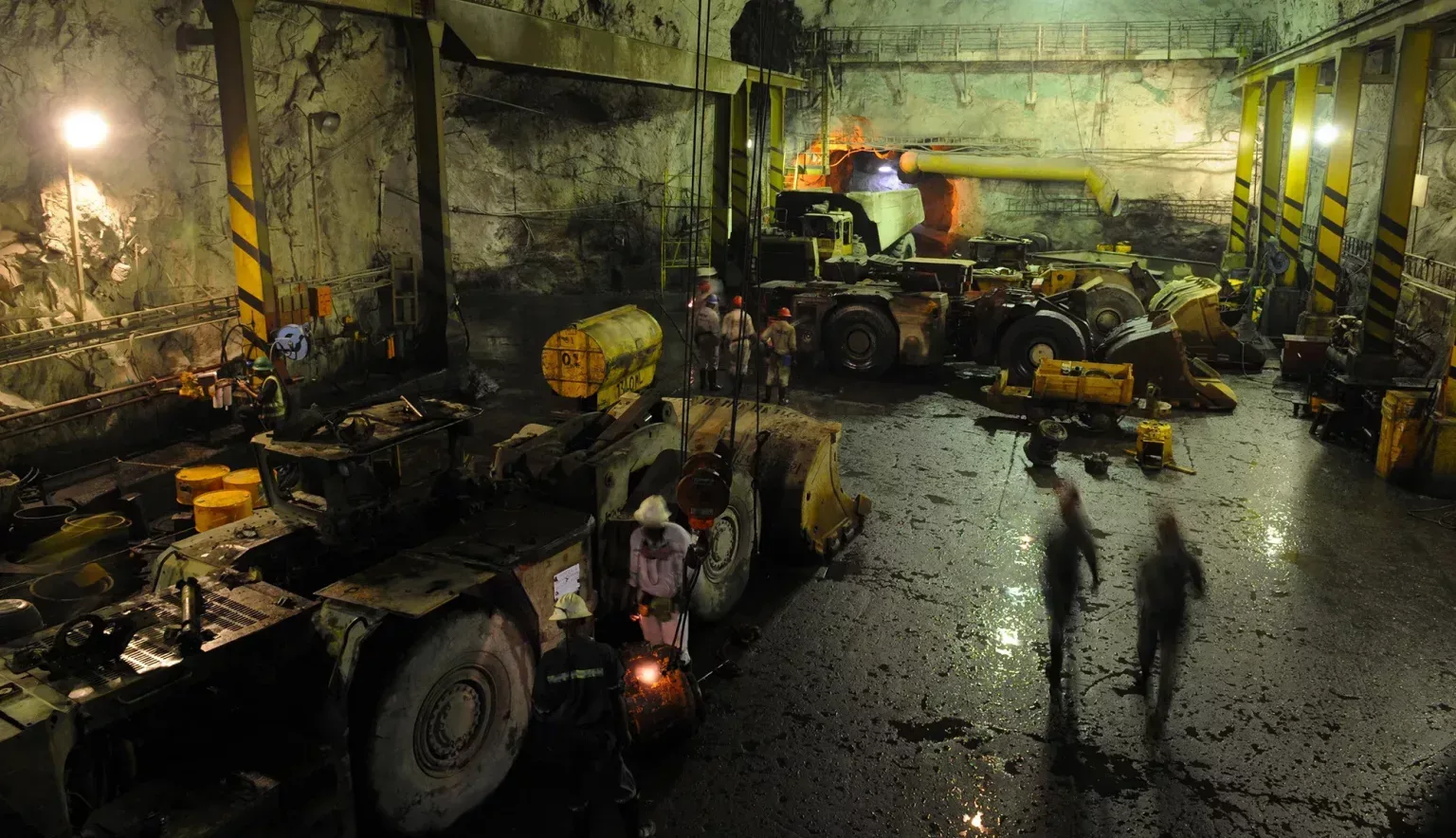RISING FROM THE ASHES
Returning to the current favourable conditions of copper on the global market, Sakanya stresses how this is contributing to a dynamic and evolving mining sector, that Mopani Copper Mines intends to exploit to its full potential.
“The current high prices are a blessing to the industry,” he comments. “The mining houses are controlling the cost of production, whilst the pricing is determined by buyers outside of our control.
“Mining has opened up in a big way in the northwest, with mines such as First Quantum Minerals (FQM), Lumwana, Kalumbila, and many more on the horizon,” he tells us.
This exciting context reflects the new age of mining that Sakanya calls for across the country, heralding an era in which profits will belong in Zambian hands to truly propel the country forward.
“Currently, Zambia is looking to increase its copper production to take advantage of the benefits of high copper prices.”
MCM’s present ownership structure represents a significant departure from the chapter in the mine’s history prior to being placed on Care and Maintenance. Indeed, the company had been state-owned up until privatisation in 2000, originally operating as part of Zambia Consolidated Copper Mines Limited (ZCCM).
It was not until 30th March 2021 that ZCCM-IH acquired 100 percent shareholding in Mopani Copper Mines. Prior to this, the company’s ownership comprised majority shareholdings from Glencore International AG (73.9 percent), FQM (16.1 percent), and ZCCM-IH (10 percent).
“Now that ZCCM-IH owns 100 percent shareholding, all MCM’s proceeds will come into Zambia,” Sakanya comments proudly.
This national investment in the company translates to a great sense of motivation for the entire team behind MCM, the majority of whom are native to Zambia.
“Our workers want to improve production, which in turn will secure their jobs,” says Sakanya. “They want to determine their own destiny by expanding operations to produce more.
“They want to show the world that Zambians are capable of operating their own mines.”
This all feeds in to Sakanya’s overarching mission to “Make Mopani Great Again.” This comprises creating value for the shareholders, making MCM an employer of choice, and creating more job opportunities for Zambians by increasing rates of production.
As the crux in driving this transformation, strategy is key in implementing Sakanya’s vision.
Having undergone a significant turnaround in the past two years, the first order of business after MCM lost the backing of Glencore International AG was to enter survival mode, simply to keep the company afloat. This entailed processes to streamline and refine operations, shedding any dead weight to keep MCM lean and agile.
“We reviewed all labour requirements, both local and expatriates and cut off any non-productive labour,” comments Sakanya.
Simultaneously, MCM set about reviewing all supplier and contractor services so that only essential and production related contracts were maintained. Similarly, MCM conducted a thorough review of the supply chain and how business was being conducted at each stage.
“We did this in order to eliminate, or at least minimise ‘corruption cartels’ in the supply chain,” he adds.
Furthermore, MCM ensured that the prices of its resources were benchmarked in line with international original equipment manufacturer (OEM) pricing and sought to encourage the local sourcing of materials and services wherever possible.
Having set the foundations for the new MCM with these companywide processes of purification, the company next turned its attention to boosting levels of production.
Again, this began with taking a second look at the mine’s pre-existing operations.
“We identified low-hanging fruits such as the reclamation production at Mufulira and Sync North. We also observed this with SOB Upper ore production at Nkana South and the reprocessing of heap leach material at the Mufulira concentrator.”
Subsequently, value-added projects were considered. This included the treatment of ores which were not economically viable at less than $6,000 per tonne of copper. These projects are now fully viable with a valuation of over $9,000 per metric tonne (pmt).
Finally, MCM economised by undertaking more tasks in-house, including repairs and the on-site fabrication of TM3 hoses.
By successfully executing the above strategy, MCM managed to emerge from times of turbulence unscathed and with the workforce intact.
“These interventions resulted in reduced costs and increased production. Plus, high copper levels resulted in MCM continuing to operate, and hence saved thousands of jobs,” Sakanya comments proudly.
THE FUTURE OF MOPANI COPPER MINES – AN INVESTMENT FOR THE NATION
A significant component of Sakanya’s journey to making MCM great again centres on producing copper cathode both safely and cost-effectively, with an increased rate of production year on year.
MCM’s aspirations of increased production are evidenced by the company’s ongoing investment strategy. Most recently, production has been impacted by major investments in three new mine shafts.
The first concerns the Synclinorium shaft, forming part of the Nkana South complex.
Commissioned in December 2017, Synclinorium will be instrumental in increasing production at Nkana South from 3,000 tonnes per day (tpd), to 7,500 tpd within the next five years. MCM also seeks to commission a new pump chamber here to commence operation in financial year 2023.
At Synclinorium, there are also plans for a new and improved concentrator that will be commissioned by the end of this year. The new plant, which will replace the old concentrator that was installed in 1932, will have the capacity to treat 3.9 million tonnes of copper cathode per year.
Secondly, there is the Mufulira shaft, which was commissioned in June 2020.
“Still outstanding at Mufulira are the underground development projects, the sub-station, pump chamber and the installation of a second underground crusher,” Sakanya explains.
“The completion of these assets will increase production to three million tonnes per year, within the next four to five years.”
Finally, sinking work has recently been completed on the Mindola Deeps shaft, with equipping works set to commence in financial year 2022.
“This project is envisaged to be complete by financial year 2023, and this too will increase production to three million tonnes per year.”
The winding plants that are being installed comprise state-of-the-art equipment that is programmable logic controller (PLC) controlled, making it easy to diagnose faults.
“This equipment can be controlled remotely in instances of fault finding from anywhere in the world,” Sakanya tells us. “The workforce is being trained to maintain this equipment by OEM specialists with technical know-how of these units.”
The culmination of these expansion projects results in an increased mine life of 25 to 30 years. Further primary exploration drilling that is currently underway will continue to increase this by another 30 years.
“Once all these projects are completed within the next two to three years, MCM will produce eight to 10 million tonnes of ore per year – almost double its current capacity.”
The plans outlined above are the nexus of MCM’s expansion strategy, which will not only significantly scale up production but also reduce production cost, on the understanding that sometimes, you have to spend money, to truly make it.
“We will lower our production cost from 700 c/lb to 350 c/lb. This will be a major milestone to achieve, since underground mining is a very costly venture,” comments Sakanya.
Indeed, with the production cost of underground mining in the third quartile, MCM will seek to increase cathode output from 82,778 tonnes in financial year 2021, to over 200,000 tonnes by 2029. This will be a staggering rise in production of 142 percent.

All corporate decisions will be made in Zambia, by Zambians, for Zambians, with Zambia’s interest at heart.
Charles Sakanya, CEO, MCM
ANSWERING MODERN DEMAND
Tying into MCM’s larger mandate of increasing production levels, in the context of a modern demand for copper, the company is diversifying in pursuit of market needs, identifying and exploring the potential of value-added operations.
“A great MCM will add value to the copper cathode by implementing value add projects such as the production of wire bars, investment in the production of parts for electric motor vehicles and the solar industry.
“It is time for Zambians to start to look at value add plants to be run in Zambia,” Sakanya states.
Fuelling this shift is the growing worldwide adaption of electric vehicles (EVs). Sakanya is fully cognisant of this market trend and intends to ensure that MCM benefits from the positioning to monetise it accordingly.
“There is an anticipated shortfall of approximately 10 million tonnes of copper cathode by the year 2030, thanks to the EV and solar industries,” he tells us.
“Such projects as drawn copper wire and the manufacture of EV parts will greatly benefit Zambia. We plan to add value to the cathode by making wire bars for export,” he tells us.
Indeed, copper is the true cornerstone of the EV revolution, with each vehicle using double the amount of the metal compared to traditional internal combustion engines. Thanks to the conductivity of the metal’s properties, a significant amount of copper wiring is required to power electric automobiles. It is also an intrinsic component in various elements of EV infrastructure, outside of the vehicles themselves.
In addition to the response to EVs and copper cathode wires, MCM is also pursuing other avenues.
“MCM can embark on value add projects such as making fertilisers out of the sulphuric acid that we produce.”
A valuable by-product, as cathode production increases, so too will the production of sulphuric acid.
“By looking at sulphuric acid production, we will make fertilisers for the agrarian revolution as part of Zambia’s diversification into agriculture,” says Sakanya.
As the most widely produced chemical in the world, around half of the world’s supply of sulphuric acid finds application in agriculture and specifically in fertilisers. As an intrinsic component to modern methods of farming, by fuelling fertiliser production with greater stock of sulphuric acid, MCM can contribute to greater crop yields across the country.
This answers the need for diversification to secure the mine’s stability, overcoming the reliance of the volatile copper market.
By pursuing these further opportunities, MCM ultimately supports more sustainable job creation.

































